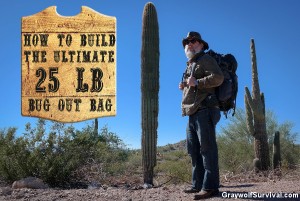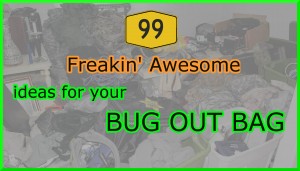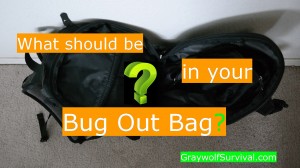So have you really thought it through what you’re prepping for?
I think that the reason people prep is because they want to be happy. There are risks out there to that happiness that they are taking steps to avoid. They realize that if they don’t do anything about things that come up that they’ll lose their happiness. They forget that sometimes and put their life out of balance and then become unhappy. Even worse, sometimes they lose their balance and prep for the wrong things and end up being unhappy twice.
Prepping is essentially all about Risk Mitigation.
Since I’ve spent a lot of time in the U.S. Army (I still have my certificate of appreciation for my time in the Cold War), I have a decent idea about how the Army does things. Why do we care about what the Army thinks? Most decisions that the military makes is not about battle decisions. It’s about prepping. The military is the ultimate prepper organization.
When you do any sort of prepping, you’re essentially hedging your bets. You’re taking today’s resources and converting it into some future gain. You believe (and rightly so) that there are hazards out there in the world that threaten you. These threats are a risk to your health, life and happiness. You learn things, buy things, make things, find things and store things in order to mitigate these risks. So, it’s basically an investment. But since you don’t have an unlimited amount of money, space and time, how do you know how to invest what you have?
That’s where this risk management stuff comes in. The Army calls it Composite Risk Management (or CRM). It’s the hated thing that people have to do before they do any sort of mission because most people just fill in the blanks and hand it in.
Done correctly, it can be immensely helpful for focusing your attention and helping you invest wisely.
I’m just gonna go easy on this stuff because it’s a military application. That means it’s overly-complicated and dry stuff. If you really want to dig deep into it, pick up a copy of FM 5-19 Composite Risk Management. This post is not a class on how to do a proper CRM. This is a hodge-podge of methods and ideas I’ve put together for expediency in my life.
Officially, there are five steps that the Army takes to their risk management:
-
Step 1 – Identify hazards.
-
Step 2 – Assess hazards to determine risk.
-
Step 3 – Develop controls and make risk decisions.
-
Step 4 – Implement controls.
-
Step 5 – Supervise and evaluate.
Step 1 – Identify hazards.
This step is pretty easy. You just look at the world and think about all the bad things that could affect your life in a way that you don’t like. The Army calls these things hazards. Specifically, it says, “A hazard is a condition with the potential to cause injury, illness, or death of personnel; damage to or loss of equipment or property; or mission degradation.”
Just remember that a hazard isn’t necessarily an enemy with a tank. Crime is a hazard and so are medical issues like airborne viruses. If it’s something that concerns you, it may be a hazard.
Step 2 – Assess hazards to determine risk.
Here’s the part that people don’t do all that well with. It sounds pretty complicated but it’s really not.
Some things out there could hurt you really bad but aren’t very likely. If the universe exploded, it would be absolutely catastrophic. It’s not very likely. As a more palatable example: a nuclear bomb exploding above your city, taking out your power grid. Much more likely to happen than the universe exploding. Much less catastrophic.
On the other hand, there are also things that aren’t so devastating but are much more likely to happen. Getting a flat tire, for example. In most circumstances, getting a flat tire is an annoyance. It’s IMMENSELY more likely to happen than a nuclear bomb going off in the sky though.
Between those two sets are lots of fuzziness. The army grades each of these into four severities and five probabilities:
- Severity
- Catastrophic
- Critical
- Marginal
- Negligible
- Probability
- Frequent
- Likely
- Occasional
- Seldom
- Unlikely
I’m not gonna go through the definitions of each because it’s not necessary. You have a dictionary if you need it.
Putting them together will give you four different categories of risk:
- L – Low risk
- M – Moderate risk
- H – High risk
- E – Extremely high risk
Here’s how they lay out those categories so you can see them easier:

As you can see, something that is frequently probable and would be catastrophic would present an extremely high risk to you and yours (E). Conversely, something that’s unlikely to happen and has negligible effects presents a low risk (L).
Let’s look at the flat tire hazard and assume that you have mediocre tires that are fairly well-worn.
How probable is it? Ahhh. Well, here’s where a lot of people mess up this tool. We’re not ready for that yet. We’ve identified a hazard but not a risk. What’s the risk due to a flat tire? In this case, there are several: getting hurt because you wrecked your car, getting in trouble because you’re delayed for work, being attacked because you’re stuck at night in a bad neighborhood, and so on.
So let’s now take one of those risks. How about ‘getting in trouble because you’re delayed for work?’
Well, in the grand scheme of things, it seldom happens. I’ve probably had about 10 flat tires in my life so you can’t really say it’s unlikely. The big thing about using this tool though is that you just put it where you think it fits best. As long as you do the same kind of in-your-head measurement to all the risks you’re looking at, it all balances out.
How severe would it be? That may depend on when it happens. If you’re like most people, it wouldn’t be all that severe because you just say it happened and then clock in. To make it more interesting, let’s say your boss is an ass and it wouldn’t be good. There’s a chance that you could be fired if you show up late. In this case, I’d call this ‘Marginal.’ It’s not life-threatening but you wouldn’t want it to happen.
So, we have a marginal threat that seldom happens. Looking at the chart, that gives you an L – for low risk.
Now, you just do the same thing for the other risks and see where they lie. I’d put ‘being attacked…’ as a catastrophic risk that’s unlikely. Why unlikely? because you probably don’t spend a lot of your time driving through bad neighborhoods. If you do, then you’d just move that up. A catastrophic risk that’s unlikely puts you at an M on the chart – Moderate risk.
If these are the only risks due to this hazard, then you’re done assessing. Time to move on to the next step, otherwise keep going.
Step 3 – Develop controls and make risk decisions.
Now you have to decide what controls you’re going to take to make sure those things don’t happen. Here are some of the things you might decide:
For being attacked:
- Avoid bad neighborhoods
- Get better tires to decrease the likelihood of a flat
- Carry a gun
- Have a cell phone on you to call for help
- Take self-defense classes
- Wear body armor
For getting in trouble for being late:
- Have a cell phone with you to call in if you’re gonna be late
- Get better tires to decrease the likelihood of a flat
- Work on your relationship with your boss
- Get a different job
For getting hurt because of a wreck:
- Get better tires to decrease the likelihood of a flat
- Take advanced driving lessons
- Drive slower
- Wear a 6″ body wrap of bubble wrap when you drive
Now technically, an organization would break those down into Who, What, Where, When and How but you get the idea.
The next step is to reassess your risk. If you decide to choose to do any of these things, your risk should change. Getting better tires may push you from a ‘seldom’ to an ‘unlikely,’ for example. This is called your Residual Risk. It’s what risk you have left over after you’ve done things about them.
After that, you need to make risk decisions. Why? At first, you might think that you should do everything you can to make sure a flat tire doesn’t affect your life. Is that feasible? Getting a different job is one thing that could help but is it worth it? What about the bubble wrap? As fun as that may be, maybe not.
Each control has a cost. Getting a different job means you’d have to do a resume, look for a job, interview and possibly take less money. Wearing bubble wrap is cheap but could impact your driving ability so you’re more likely to get in a wreck overall.
Step 4 – Implement controls.
In this case, you just do the stuff you said you were gonna do. This is a section by itself for the FM because actually doing something in the Army can be a bit complicated.
Step 5 – Supervise and evaluate.
Once you’ve gotten new tires or whatever you’re gonna do, you need to see if things have improved. Let’s say you decided that getting along with your boss better was one of your solutions that you implemented. How’s that going? Is it less likely you’d get in trouble if you were late? Did you make things worse?
Sooo. Why did we go through all this in the first place?
You need to prioritize what you’re prepping for
Prepping for the complete collapse of society is not only a huge complicated and expensive project, it’s not as likely to happen as things like a house fire, losing your job or getting hurt in a car accident. If you’re building an underground bunker and don’t have a couple of months of expenses saved up, your priorities are out of whack.
I see this crap mainly from people who say that you shouldn’t have a newer car or put anything on a thumb drive or Kindle because they say when SHTF there won’t be any electronics. That’s just pure crap. Sure, there’s the slightest possibility that that may happen, and you should absolutely be ready in case it does, but 99.99999% of other things you have to deal with will still allow you to have electronics. I don’t discount an EMP/CME threat at all but come on. It’s not the only threat out there and certainly not the most likely.
You need to prioritize what steps you’re gonna take
That nitty-gritty stuff above is the nuts and bolts of your prepping plan. You don’t really need to go through it all and assign categories like we do in the Army. You should do this at a high level though and then break things down as you go. A typical prepper is concerned with more than just a flat tire. You need to look at all the hazards and how they could affect your life. Then break them down into things that you can do something about. Compare the costs of those things and decide what to do.
Did you notice that getting better tires was on all three lists? That one step can help mitigate several risks. If you’ve done this with several hazards, you’ll see that doing one thing may help with a LOT of risks. This is where you should be focusing your attention.
Here’s where the skills vs stuff thing really comes into play. What you’ll find is that buying stuff can help control risks because you may have that stuff available when you need it. Stuff though has a cost in money, space, time and weight. And – you may not have it with you when you need it.
Skills though don’t cost space or weight – and you always have them with you. Learning takes time and sometimes money (although with the advent of the internet, that cost is usually negligible) though, so it’s not free.
You need balance in your life
Here’s another thing. By breaking things down into real life risks, you can start to see that there are bigger risks to your life that are more likely to make you unhappy than some of the things you’ve probably been focusing on. By coming at this as an investment in your happiness, you can see that there are other things that are at risk that you may not be thinking of. What about your family? Do you spend enough time with them or are you always on the computer learning how to rub two sticks together? What about your friends? Do you invest time with them? Do you have friends? What about hobbies that aren’t prepper-specific?
The whole reason I wrote this article is because every time someone brings up getting a ham radio, some idiot will post that it’s a stupid idea because the government will be able to track you down. Really? Is that the only thing you’re worried about? Why are you on the internet? Another is that when people bring up keeping documents and references on thumb drive and something like a kindle paperwhite, that same idiot screams that you won’t be able to use that if there’s an EMP. – Really? So you’re gonna actually print out 10,000 pages of books, laminate them and keep them in your bugout bag? Because that’s how many pages I have in my thumb drive and my kindle. I also keep a few pages of laminated emergency information but you can’t fit too much on there. Good luck with your memorization of all that information and I hope you don’t have to rely on anyone else. You seriously need to loosen up the tin foil around your head and look at ALL scenarios, not just the ones that are all over the bullshit websites you’ve been reading.
Stop and take account of what you’re prepping for, why you’re doing it – and plan ahead. You’re not a hoarder, you’re a prepper. Start acting like one.











Would you let my wife know that I’m not a hoarder?! Great article, I am going to use this information to help plan for situations with my group.
lol. Just tell her a hoarder is a collector without a plan.
Great article Graywolf, I was having a discussion with my son about assessment and mitigation of possible situations and he described to me what he considered critical thinking, much inline with your article here. I must link this to him for consideration, outstanding insight, Graywolf. thank you very much….
Thanks David. It’s a topic I’m flushing out for the book. It’s important to have balance in your life and if you’re gonna spend so much money and time into something like prepping, you need to think it through. It’s nice that I’m not the only one who has discussions like this with my kids.
If there is any such thing as a ” nube ” in the wonderful world of prepping, then that would be me. I have been reading alot of your articles and this one, just like the rest, has opened my eyes to a more logical way of thinking and how to go about prepping. Luckily for me my wife is also very interested in prepping and the method you speak of here is going to be an awesome way for us to go about our prepping journey. I also think that when the time comes for our little girl to help mommy and daddy to preppare for whatever situation we are prepping for, this will be easy for her to understand. I think that we could even turn it into a game to see who can come up with the best idea to help with whatever situation we are preparing for. As with all of your articles, this awesome advice!
Hey Graywolf, I need you here, now, today!
I’m waiting!
I’m tired of going this alone, my kids think I’m nuts, get no help there.
They say God will provide, I say God says, get off your assssss and DO SOMETHING TOO!